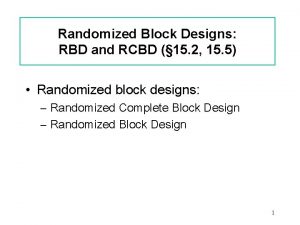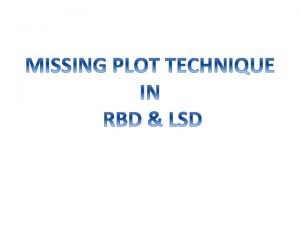A Randomised Controlled Trial Evaluating the Efficacy of

- Slides: 1

A Randomised Controlled Trial Evaluating the Efficacy of Neurovision's Neural Vision Correction Technology in Enhancing Unaided Visual Acuity in Adults with Low Myopia Singapore Eye Research Institute Allan Fong 1, 2, Donald Tan 1, 2, 3 Singapore Eye Research Institute (SERI)1; Singapore National Eye Centre (SNEC)2; 3 Department of Ophthalmology, Yong Loo Lin School of Medicine, National University of Singapore Introduction Methods Neuro. Vision™ NVC vision correction technology is a non-invasive, patient-specific treatment based on visual stimulation and facilitation of neural connections responsible for vision. The technology involves the use of an internet-based computer generated visual training exercise regime using sets of patient specific stimuli based on Gabor patches, to sharpen contrast sensitivity and visual acuity. § Adults aged 17 -55, with Low Myopia, having cycloplegic spherical equivalent (SE) in the range of -0. 5 DS to – 1. 5 DS and astigmatism in the range of 0. 0 DC to -0. 75 DC were recruited. Previously, in a pilot non-comparative study 1, it has been demonstrated by the same authors that Neuro. Vision’s Neural Vision Correction (NVC ) Technology has shown efficacy in enhancing unaided visual acuity in adults with low myopia. The purpose of this study is to evaluate in a double masked randomized controlled trial the efficacy of Neuro. Vision’s Neural Vision Correction (NVC ) Technology in enhancing unaided visual acuity in adults with low myopia. § A total of 124 patients were enrolled. Subjects were randomly divided into 2 groups: Group A (98 patients) and Group B (26 patients) § The study was double masked. § UAVA was tested at Baseline and at the End of Treatment using ETDRS charts. § A significant improvement in UAVA was defined as improvement in UAVA of 0. 2 log. Mar (2 lines) or more. § Analysis was conducted only for those subjects who completed Neuro. Vision or sham treatment without any major incompliance with the treatment schedule and protocol, and baseline Unaided Visual Acuity (UAVA) in both eyes was 0. 2 log. Mar (20/32) or worse. This would include 67 patients in Group A and 17 patients in Group B. Scientific Background Results Cortical neurons in the visual cortex function as highly specialized image analyzers or filters, responding only to specific parameters of a visual image, such as orientation and spatial frequency, and visual processing involves the integrated activity of many neurons, with inter-neural interactions effecting both excitation and inhibition 2. Visual contrast activates neurons involved in vision processing, and neural interactions determine the sensitivity for visual contrast at each spatial frequency, and the combination of neural activities set Contrast Sensitivity Function (CSF)2, 3. The relationship between neuronal responses and perception are mainly determined by the signal-to-noise ratio (S/N ratio) of neuronal activity, and the brain pools responses across many neurons to average out noisy activity of single cells, thus improving S/N ratio, leading to improved visual performance and acuity 4. § See Table 1 for summary of baseline VA, end of treatment VA and improvement of VA. Studies have shown that the noise of individual neurons can be brought under experimental control by appropriate choice of stimulus conditions, and CSF can be increased dramatically through control of stimulus parameters 5 -9. This precise control of stimulus conditions leading to increased neuronal efficiency is fundamental in initiating the neural modifications that are the basis for brain plasticity 10, 11. Brain plasticity (the ability to adapt to changed conditions in acquiring new skills) has been demonstrated in many basic tasks, with evidence pointing to physical modifications in the adult cortex during repetitive performance 12, 13. Neuro. Vision’s technology probes specific neuronal interactions, using a set of patientspecific stimuli that improve neuronal efficiency 7, 14, 15 and induce improvement of CSF due to a reduction of noise and increase in signal strength. As visual perception quality depends both on the input received through the eye and the processing in the visual cortex, Neuro. Vision’s technology compensates for blurred (myopic) inputs, coming from the retina, by enhancing neural processing. Technology Implementation The building block of these visual stimulations is the Gabor patch (Figure 1), which efficiently activates and matches the shape of receptive field in the Visual Cortex. The fundamental stimulation-control technique is called “Lateral Masking”, where collinearly oriented flanking Gabors are displayed in addition to the target Gabor image. The patient is exposed to two short displays in succession, in a random order; the patient identifies which display contains the target Gabor image (Figure 2). Audio feedback is provided with an incorrect response. The task is repeated and a staircase is applied until the patient reaches their visual threshold level. First Display Second Display § Mean Unaided Visual Acuity (UAVA) improved in Group A by 0. 186 log. Mar vs. 0. 023 log. Mar in Group B. § See Table 2 for summary of statistical analysis § Mean refractive error remained unchanged. No adverse events were reported. Table 1. Summary of baseline VA, end of treatment VA, and improvement of VA Group A (n = 67) Group B (n = 17) Right eye baseline unaided VA (log. Mar) Mean (SD) Median (range) 0. 43 (0. 15) 0. 40 (0. 20 – 0. 80) 0. 35 (0. 10) 0. 38 (0. 20 – 0. 50) Left eye baseline unaided VA (log. Mar) Mean (SD) Median (range) 0. 44 (0. 16) 0. 42 (0. 20 – 0. 76) 0. 33 (0. 11) 0. 30 (0. 20 – 0. 62) Right eye end of treatment VA (log. Mar) Mean (SD) Median (range) 0. 25 (0. 16) 0. 24 (-0. 30 – 0. 56) 0. 29 (0. 17) 0. 28 (-0. 12 – 0. 70) Left eye end of treatment VA (log. Mar) Mean (SD) Median (range) 0. 26 (0. 18) 0. 26 (-0. 30 – 0. 66) 0. 33 (0. 16) 0. 30 (0. 14 – 0. 62) Improvement of right eye VA (log. Mar) Mean (SD) Median (range) 0. 19 (0. 15) 0. 18 (-0. 14 – 0. 60) 0. 07 (0. 14) 0. 08 (-0. 26 – 0. 34) Improvement of left eye VA (log. Mar) Mean (SD) Median (range) 0. 18 (0. 16) 0. 18 (-0. 28 – 0. 56) 0. 006 (0. 15) 0. 04 (-0. 30 – 0. 24) Table 2. Summary of Statistical Analysis Average Improvement in UAVA % of subjects who improved 2 Lines or above in Both Eyes % of subjects who improved 2 Lines or above in at least One Eye Figure 1: The Gabor Patch Figure 2: Lateral Masking images The Neuro. Vision System is a software-based, interactive system tailored and continuously adaptive to the individual visual abilities. In the first stage, the subject is exposed to a set of visual perception tasks, aimed to analyze and identify each subject’s neural inefficiencies or deficiencies. Based on this analysis, a treatment plan is initialized, and subject specificity is achieved by administering patient-specific stimuli in a controlled environment. Each session is designed to train, directly and selectively, those functions in the visual cortex, which were diagnosed to be further enhanced. At each session an algorithm analyzes the patient's responses and accordingly adjusts the level of visual difficulty to the range most effective for further improvement. Between sessions, the progress of the patient is taken into account by the algorithm for the next session generation. Thus, for each subject an individual training schedule is designed based on the initial state of visual performance, severity of dysfunction and progress in course of treatment. The treatment is applied in successive 30 -minute sessions, administered 2 -3 times a week, a total of approximately 30 sessions. Every 5 sessions, subject’s visual acuity is tested in order to continuously monitor subject’s progress. The average entire treatment duration is around 3 months. Group A (n = 67) Group B (n = 17) Statistical Significance (p) Odds Ratio 95% Confidence Interval 0. 186 log. Mar 0. 023 log. Mar 21 (31. 3%) 1 (5. 9%) p=0. 034 Fisher’s Exact Test 7. 304 0. 908 to 58. 771 43 (64. 2%) 2 (11. 8%) p<0. 0005 Chi-square Test 13. 438 2. 830 to 63. 796 Conclusions A higher percentage of the adults with low myopia in Group A demonstrated significant improvement in vision compared to those in Group B, and this is statistically significant. We have yet to unmask the two groups, as final follow up of both groups post-treatment is underway. References 1. 2. 3. 4. 5. 6. 7. 8. 9. 10. 11. 12. 13. 14. 15. Donald T. H. Tan, Allan Fong, . Efficacy of neural vision therapy to enhance contrast sensitivity function and visual acuity in low myopia. J Cataract Refract Surg 34: 570– 577 (2008) Hubel, D. H. & Wiesel, T. N. Receptive fields, binocular interaction and functional architecture in the cat's visual cortex. J. Physiol. (Lond. ) 160, 106 -154 (1962). Polat, U. Functional architecture of long-range perceptual interactions. Spat Vis 12, 143 -62 (1999). Geisler, W. S. & Albrecht, D. G. Visual cortex neurons in monkeys and cats: detection, discrimination, and identification. Vis Neurosci 14, 897 -919 (1997). Kasamatsu, T. , Polat, U. , Pettet, M. W. & Norcia, A. M. Colinear facilitation promotes reliability of single-cell responses in cat striate cortex. Exp Brain Res 138, 163 -72. (2001). Polat, U. , Mizobe, K. , Pettet, M. W. , Kasamatsu, T. & Norcia, A. M. Collinear stimuli regulate visual responses depending on cell's contrast threshold. Nature 391, 580 -4 (1998). Polat, U. & Sagi, D. Spatial interactions in human vision: from near to far via experience- dependent cascades of connections. Proc Natl Acad Sci U S A 91, 1206 -9 (1994). Polat, U. & Sagi, D. Lateral interactions between spatial channels: suppression and facilitation revealed by lateral masking experiments. Vision Res 33, 993 -9 (1993). Polat, U. & Sagi, D. The architecture of perceptual spatial interactions. Vision Res 34, 73 -8 (1994). Dosher, B. A. & Lu, Z. L. Perceptual learning reflects external noise filtering and internal noise reduction through channel reweighting. Proc Natl Acad Sci U S A 95, 13988 -93. (1998). Dosher, B. A. & Lu, Z. L. Mechanisms of perceptual learning. Vision Res 39, 3197 -221. (1999). Sagi, D. & Tanne, D. Perceptual learning: learning to see. Curr Opin Neurobiol 4, 195 -9 (1994). Gilbert, C. D. Adult Cortical Dynamics. Physiological Reviews 78, 467 -485 (1998). Polat, U. & Sagi, D. in Maturational Windows and Adult Cortical Plasticity (eds. Julesz, B. & Kovâcs, I. ) 1 -15 (Addison. Wesley, 1995). Polat, U. , Ma-Naim, T. Belkin, M. Sagi, D. Improving vision in adult amblyopia by perceptual learning. PNAS 101, 669297 (2004).

